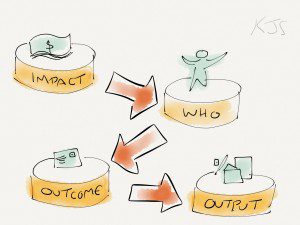I mentioned that I had a great conversation with Gojko Adzic at Lean Agile Scotland. During that discussion, Gojko also described a technique he call Impact Mapping. Since then has published a short book on Impact Mapping which I highly recommend.
An Impact Map can be thought of as a structured mind map, with the following levels being used to articulate the various aspects of an initiative:
- Why – The central node describes the goal of the initiative in a quantative manner such that it can be measured.
- Who – These are the people who can either be a help or a hindrance in achieving the goal.
- How – These are impacts that need to be had on the actors for them to either help achieve the goal, or minimise/avoid them being a hindrance.
- What – These are the deliverables which are hoped will create the impact on the actors to achieve the goal.
There are a number of reasons I like the approach and find it coherent with my experiences.
- Impact Maps build on Simon Sinek’s Golden Circle, which I have written about in the past. The additional Who level helps bridge the gap and identify the different Hows .
- Impact Maps also provides a framework against which to iterate and increment using story maps, feature injection and fidelity. In particular, having the SMART goal means that the development is more likely be stopped at the right time because the the deliverables have had the desired impact, or because they are not having the anticipated impact. Alternatively, development might even be avoided because alternative deliverables are identified which will generate enough impact to achieve the goal.
- The language of Impact Maps is very close the language I use of Impacts, Outcomes and Outputs. For me, the Why is the Impact – it is the overall impact we want the initiative to have. The Who remains the people who can help or hindering achieving the Impacts. The How are the Outcomes which will help the actors achieve the Impact (or minimise/avoid hindrance), and the What are the Outputs required to create the Outcomes.
Regardless of the subtle differences of language, its still a great technique, and is one I’m looking forward to using in the future.



I also like this technique. I’d better like to use the words “impacts” and “deliverables” for “how” and “what”.
For the why, the vision box (innovation games) can help to define the goal. Personae can be used for the who and the link to impacts. And with the impacts, you can find the deliverables needed to reply to the impacts. An another way is to add a “prune the product tree”.
I also think that the impact mapping is not enough to start a project because you also need to estimate (20/20, planning poker) and to get the priorization (prune the product tree, buy a feature)